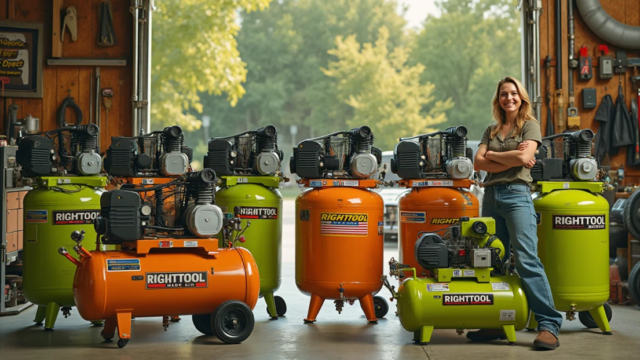Find the Perfect Match for Your Projects
Choosing the right air compressor can make a big difference for your projects. Whether you’re a DIY enthusiast or a pro, picking the best one matters. The best air compressor for you depends on your specific needs, including the tools you’ll use and how often you’ll use them.
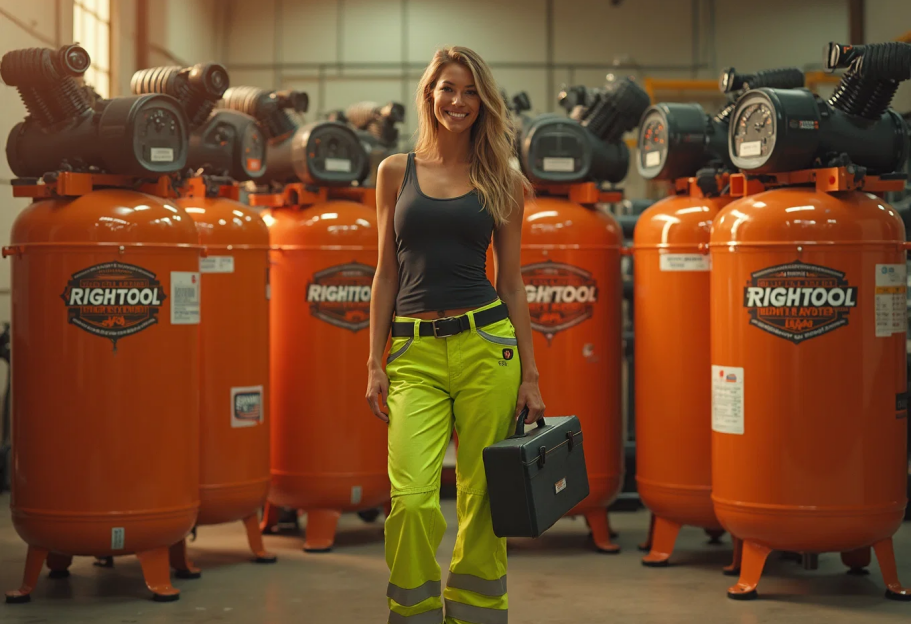
Air compressors come in different types and sizes. Some are small and portable, great for home use. Others are big and powerful, ideal for industrial jobs. You’ll want to think about things like power source, air flow, and pressure when deciding.
This guide will help you understand what to look for in an air compressor. We’ll cover the main types of compressors and key features to consider. By the end, you’ll feel ready to pick the perfect air compressor for your needs.
Key Takeaways
- Your specific needs determine the best air compressor for you
- Consider factors like power source, air flow, and pressure when choosing
- Proper maintenance ensures your air compressor performs well over time
Understanding Air Compressors

Air compressors are machines that convert power into potential energy stored in pressurized air. They work by forcing air into a tank, increasing the pressure inside.
The main components of an air compressor include:
- Motor or engine
- Pump
- Tank
- Pressure switch
- Regulator
You’ll often see two key specifications when looking at air compressors: PSI and CFM. PSI (pounds per square inch) measures pressure, while CFM (cubic feet per minute) indicates air flow.
Different types of air compressors exist:
- Reciprocating (piston)
- Rotary screw
- Centrifugal
Each type has its own strengths and ideal applications. Reciprocating compressors are common in small shops and garages. Rotary screw models often suit industrial settings.
When choosing an air compressor, consider your specific needs. Think about the tools you’ll use and their air requirements. Match the compressor’s output to your tools’ demands.
Tank size affects how long you can use air tools before the compressor needs to refill. Larger tanks allow for longer continuous use.
Remember, proper maintenance is crucial for your air compressor’s performance and lifespan. Regular oil changes and filter replacements help keep it running smoothly.
Determining Your Requirements
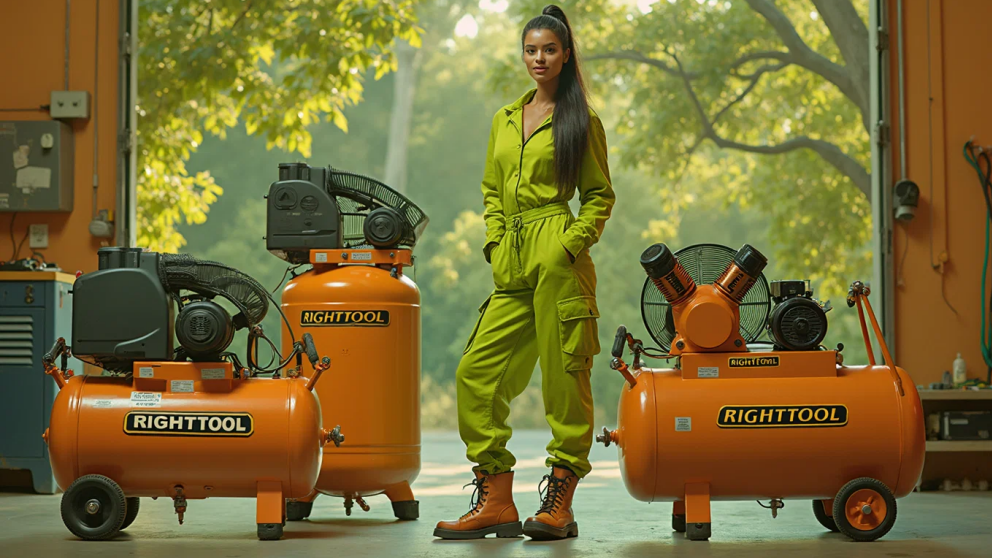
Picking the right air compressor starts with knowing what you need. You’ll want to think about the pressure, volume, and how often you’ll use it. The tools you plan to use also matter a lot.
Assessing the Demand for Pressure and Volume
To choose the best air compressor, you need to know about PSI and CFM. PSI stands for pounds per square inch. It measures pressure. CFM means cubic feet per minute. It measures air volume.
Different tools need different PSI and CFM. Here’s a quick guide:
- Nail guns: 70-90 PSI, 2-3 CFM
- Impact wrenches: 90-100 PSI, 3-8 CFM
- Paint sprayers: 40-60 PSI, 6-9 CFM
Always check your tools’ needs before buying a compressor. Add up the CFM for all tools you might use at once. Then add 25% extra for safety. This tells you the CFM you need.
Evaluating the Frequency of Use
How often you’ll use your air compressor is key. It affects the type you should buy.
For occasional use, like inflating tires or small DIY jobs, a portable compressor might work. These are usually cheaper and easier to move around.
If you plan to use it daily or for long periods, you’ll need a bigger, more powerful unit. These can handle constant use without overheating.
Think about your future needs too. It’s often better to buy a bit more capacity than you think you need now.
Considering the Types of Tools and Applications
The tools you’ll use with your compressor are crucial in making your choice. Different tools have different air needs.
For light-duty tools like nail guns or staplers, a small compressor might be enough. But for sanders, grinders, or spray guns, you’ll need more power.
Here’s a list of common tools and their typical needs:
- Spray guns: High CFM, low to medium PSI
- Sandblasters: High CFM and PSI
- Pneumatic wrenches: Medium CFM, high PSI
If you’re using multiple tools, make sure your compressor can handle the highest CFM tool. This ensures you have enough air for all your needs.
Don’t forget about special applications. For example, painting needs clean, dry air. You might need extra filters or an oil-free compressor for this.
Types of Air Compressors
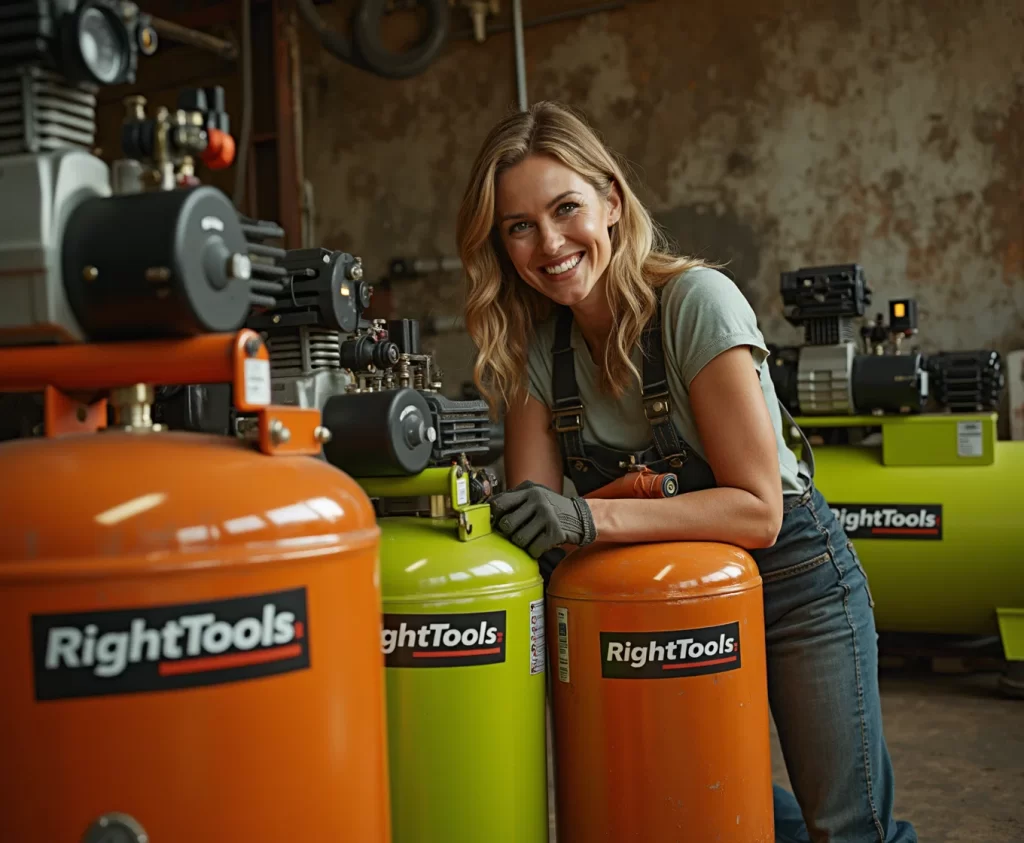
Air compressors come in various types, each designed for specific tasks and environments. Your choice depends on factors like power needs, portability, and maintenance requirements.
Portable vs. Stationary Compressors
Portable compressors are great for job sites or small workshops. They’re easy to move and ideal for tasks that require mobility. Portable air compressors often have wheels and handles for easy transport.
Stationary compressors are bigger and more powerful. They’re perfect for large workshops or industrial settings where constant air supply is needed. These units are fixed in place and can handle heavy-duty tasks.
Your choice depends on your workspace and the jobs you’ll do. If you need to move around, go portable. For a fixed location with high demand, pick stationary.
Electric vs. Gas Compressors
Electric compressors are popular for indoor use. They’re quieter and don’t produce fumes. You can use them in enclosed spaces without worry. They’re also easier to maintain and start up quickly.
Gas compressors offer more power and don’t need an electrical outlet. They’re great for outdoor use or remote locations. However, they’re louder and require more upkeep.
Consider your work environment and power needs when choosing. Electric is best for indoor, regular use. Gas is ideal for outdoor jobs or places without easy access to electricity.
Oil-Free vs. Oil-Lubricated Compressors
Oil-free compressors are low-maintenance and environmentally friendly. They’re great for tasks that need clean air, like painting or food processing. You don’t need to change oil or worry about oil contamination.
Oil-lubricated compressors last longer and run cooler. They’re better for heavy-duty, continuous use. However, they need regular oil changes and can’t be used where oil-free air is required.
Your choice depends on your air quality needs and maintenance preferences. Go oil-free for clean air and less upkeep. Choose oil-lubricated for durability and heavy use.
Single-Stage vs. Two-Stage Compressors
Single-stage compressors compress air once before storage. They’re simpler and cheaper. These are good for light to medium-duty tasks like inflating tires or using nail guns.
Two-stage compressors compress air twice, reaching higher pressures. They’re more efficient for continuous use and high-demand tasks. These are ideal for industrial settings or large workshops.
Pick based on your pressure needs and usage frequency. Single-stage works for occasional use. Two-stage is better for constant, high-pressure demands.
Piston vs. Rotary Screw vs. Centrifugal Compressors
Piston compressors, also called reciprocating compressors, use pistons to compress air. They’re common in small to medium-sized applications. Reciprocating air compressors are great for home workshops and small businesses.
Rotary screw compressors use two rotating screws to compress air. They provide continuous airflow and are quieter than piston types. These are ideal for industrial use or large-scale operations.
Centrifugal compressors use a high-speed impeller to compress air. They’re best for very high-volume, continuous air needs. You’ll find these in large industrial settings.
Your choice depends on your air volume needs and budget. Piston compressors are versatile and affordable. Rotary screw offers continuous flow for bigger jobs. Centrifugal is for the largest industrial applications.
Power Source and Energy Efficiency
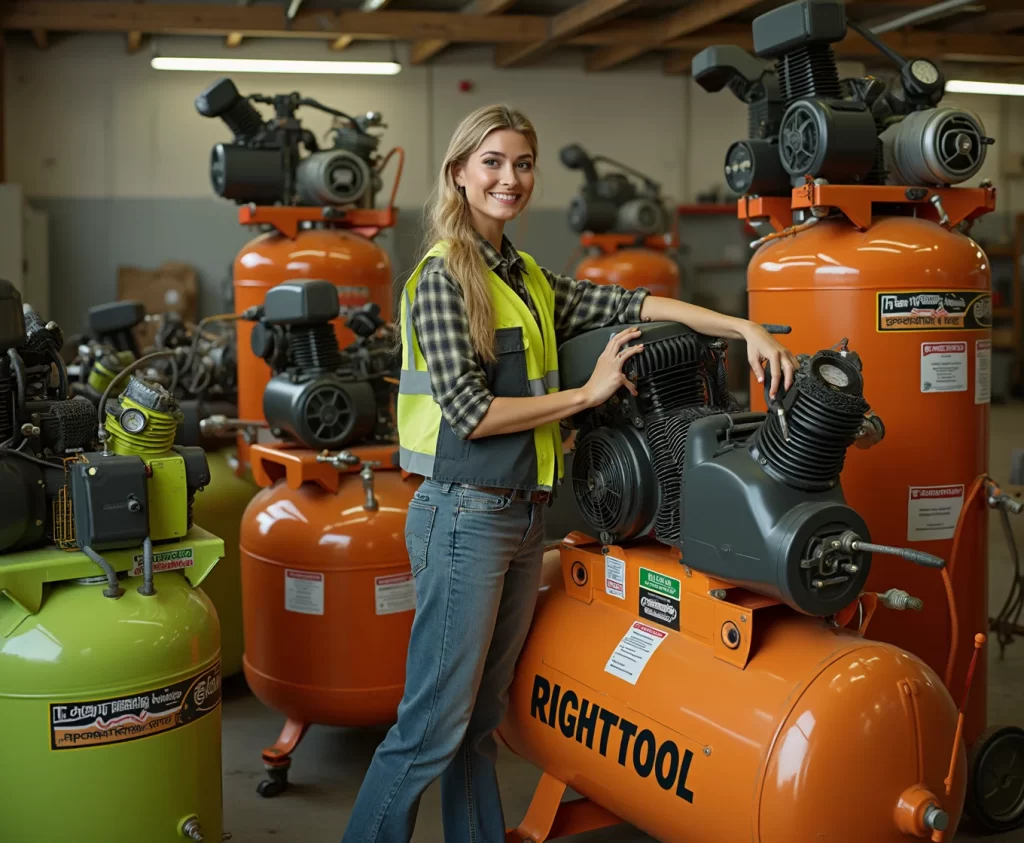
Air compressors come with different power options and energy efficiency ratings. These factors affect performance, running costs, and suitability for various environments.
Choosing Between Electric and Gas Power
Electric air compressors are popular for indoor use. They’re quiet and easy to maintain. You can plug them into standard outlets for most home and shop tasks.
Gas-powered compressors offer more mobility. They’re great for outdoor jobs where electricity isn’t available. Keep in mind they produce fumes, so don’t use them in enclosed spaces.
Your choice depends on where you’ll use the compressor. Electric models work well for garages and workshops. Gas compressors are better for construction sites or remote areas.
Understanding the Impact on Energy Costs
Energy efficiency is key to keeping your air compressor costs down. Look for models with high CFM (cubic feet per minute) ratings at lower horsepower. This means they produce more air with less energy.
Variable speed drives can boost efficiency. They adjust the motor speed to match air demand. This reduces energy waste during low-use periods.
Heat recovery systems can save energy too. They capture waste heat from the compressor to warm your space or water. This dual-use of energy can cut overall costs.
Regular maintenance is crucial for efficiency. Clean or replace filters often. Check for air leaks in your system. These simple steps can significantly reduce energy use and extend your compressor’s life.
Performance and Maintenance

Picking the right air compressor is only the first step. You need to understand how to get the best performance and keep it running smoothly. Let’s look at key metrics, maintenance tips, and cooling needs.
Key Performance Metrics to Consider
When choosing an air compressor, pay attention to these important metrics:
- CFM (Cubic Feet per Minute): This measures how much air the compressor can deliver. Match the CFM to your tools’ needs.
- PSI (Pounds per Square Inch): This is the air pressure the compressor can produce. Higher PSI means more power for your tools.
- Duty Cycle: This tells you how long the compressor can run before needing a break. A longer duty cycle means less downtime.
- Horsepower: More horsepower usually means better performance, but it also uses more energy.
Efficiency is key. Pick a compressor that meets your needs without wasting power.
Routine Maintenance for Reliability
Regular upkeep keeps your air compressor running well. Here’s what you should do:
- Check and change the oil regularly (for oil-lubricated models)
- Clean or replace air filters monthly
- Drain the tank after each use to prevent rust
- Tighten all fittings and belts as needed
- Inspect hoses for leaks or wear
Proper maintenance extends your compressor’s life and prevents breakdowns. Keep a log of all maintenance tasks.
Set reminders for these tasks. It’s easier to do small jobs regularly than face big repairs later.
Managing Heat and Cooling Requirements
Air compressors generate heat while running. Too much heat can damage the motor and other parts. Here’s how to keep things cool:
- Place your compressor in a well-ventilated area
- Clean cooling fins regularly to remove dust
- Use a larger tank to reduce run time and heat buildup
- Consider an oil-cooled model for heavy-duty use
For big jobs, you might need extra cooling. Some compressors have built-in aftercoolers or can use separate cooling systems.
Heat management is crucial for your compressor’s lifespan. A cool compressor is a happy compressor.
Sizing and Storage
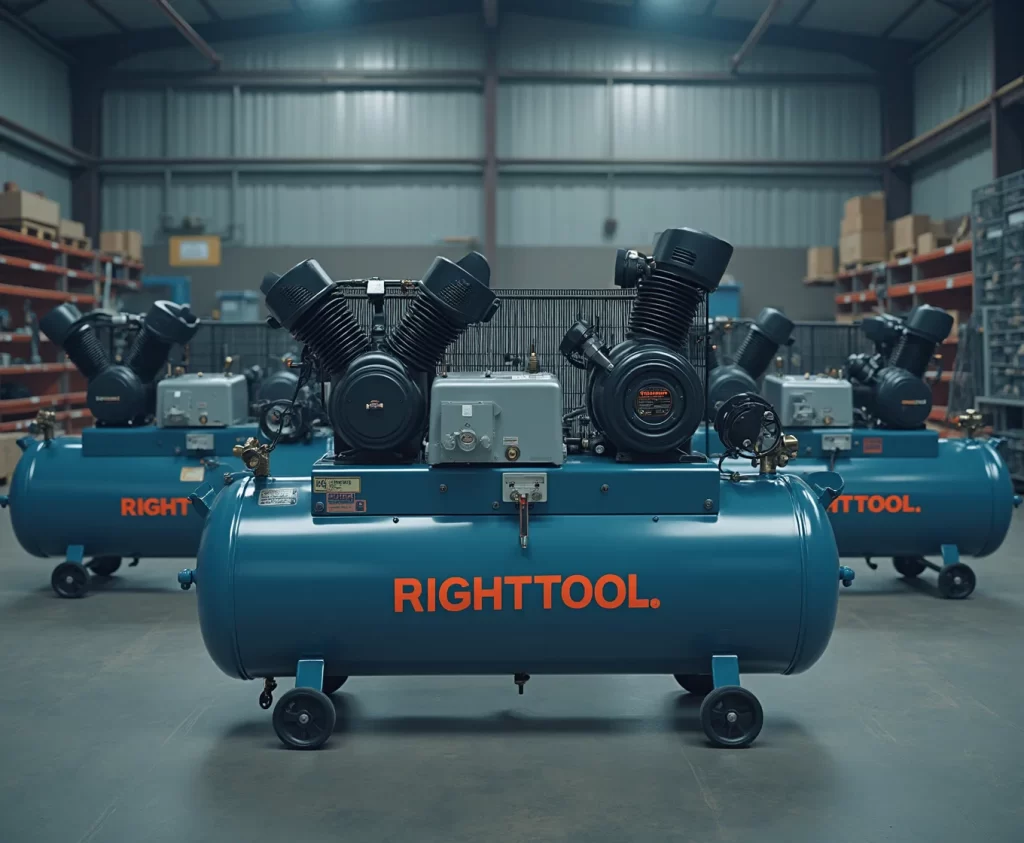
Choosing the right air compressor size and finding a suitable storage location are crucial for optimal performance and convenience. Let’s explore how to determine the appropriate tank size and consider space requirements for storage.
Determining the Right Tank Size
Tank size affects how long you can run air tools before the compressor needs to refill. Smaller tanks work for occasional use with nail guns or inflation tasks. Larger tanks are better for continuous use or powering multiple tools.
For small jobs, a 20 to 30 gallon tank is often sufficient. Bigger projects may need 60 to 80 gallons. Consider your tools’ air requirements when choosing a size.
Check the CFM (cubic feet per minute) ratings of your tools. Add up the CFM needs of tools you’ll use simultaneously. Pick a compressor with a CFM rating that meets or exceeds this total.
Space Considerations for Storage
Your available space impacts what size compressor you can accommodate. Measure the area where you plan to keep the compressor before buying.
Portable compressors are great for small workshops or if you need to move the unit. They typically have wheels for easy transport. Stationary compressors are better for larger spaces or permanent setups.
Consider noise levels if storing the compressor in a home garage or workshop. Some models are quieter than others. Assess your power supply options in the storage location. Ensure you have the right electrical outlets or fuel sources available.
Proper ventilation is important for air compressor storage. Allow enough space around the unit for air circulation and cooling. This helps prevent overheating and extends the compressor’s lifespan.
Additional Features and Accessories
Air compressors come with various extras that can boost their performance and make them easier to use. These add-ons can help you get more out of your machine and keep it running smoothly.
Hoses, Fittings, and Connectors
Air hoses are essential for delivering compressed air to your tools. Choose hoses made of durable materials like rubber or polyurethane. These can withstand high pressures and resist kinking.
Fittings and connectors link your hose to the compressor and tools. Quick-connect fittings let you switch tools fast. Make sure to pick fittings that match your hose and tool sizes.
For safety, use hose whip checks. These prevent hoses from whipping around if they disconnect under pressure.
Gauges and Control Systems
Gauges help you monitor your compressor’s performance. A pressure gauge shows the air pressure in the tank. This lets you know when to stop or start the compressor.
Control systems can make your compressor more efficient. An auto shut-off feature turns the compressor off when it reaches a set pressure. This saves energy and extends the life of your machine.
Some compressors have digital controls. These can give you more precise pressure settings and easier operation.
Air Dryers and Filters
Air dryers remove moisture from compressed air. This is crucial for many applications. Wet air can damage tools and affect paint finishes.
Filters clean the air by removing dust, oil, and other particles. This protects your tools and ensures clean air for sensitive tasks like painting.
There are different types of air dryers and filters. Choose based on your air quality needs and the tasks you’ll be doing.
Regular maintenance of these components is key. Clean or replace filters as needed to keep your air clean and your compressor running well.
Choosing the Best Air Compressor for Specific Needs
Picking the right air compressor depends on your specific needs. Different tasks and settings require different types of compressors to work efficiently.
For the DIY Enthusiast
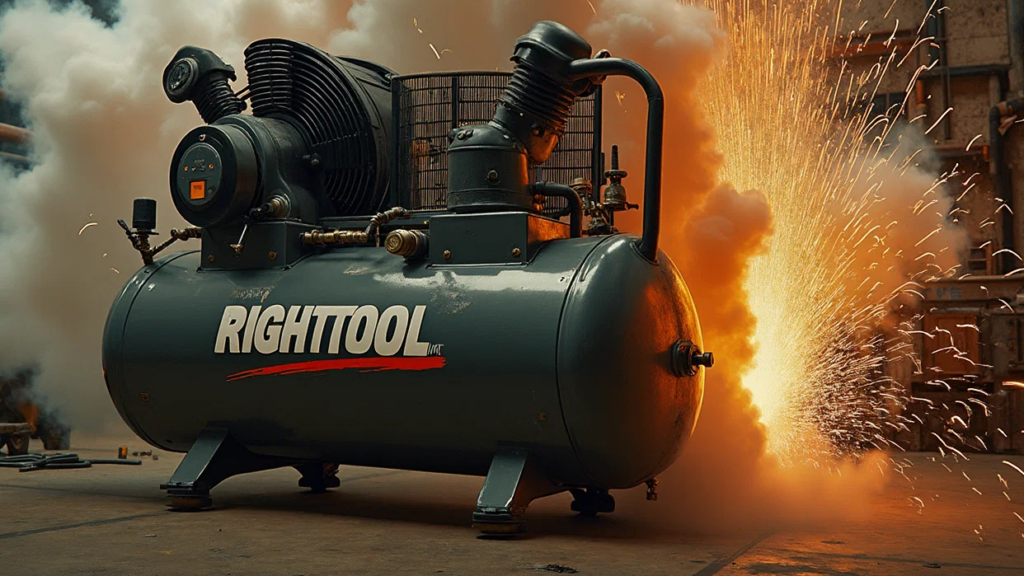
DIY projects often need a versatile air compressor. Look for portable options with enough power for common tasks. A small to medium-sized tank is usually sufficient.
Consider these features:
- 2-6 gallon tank
- 90-150 PSI max pressure
- 2-3 CFM at 90 PSI
Oil-free models are great for DIY use. They need less maintenance and work well for occasional use. Make sure the noise level is bearable for home use.
Choose a compressor that can handle your most demanding tools. Nail guns and impact wrenches often need more air than other tools.
For Heavy-Duty Industrial Applications
Industrial settings need powerful, durable compressors. These machines run for long periods and must be reliable.
Key factors to consider:
- High CFM output
- Large tank size (60+ gallons)
- Robust construction
Rotary screw compressors are often ideal for industrial use. They provide constant airflow and can run continuously.
Look for features like:
- Two-stage compression
- Cast iron pumps
- Efficient cooling systems
Industrial compressors should match your power needs. Check if your facility can handle the electrical requirements of large units.
For Automotive Work and Manufacturing Plants
Automotive and manufacturing work needs powerful compressors that can run multiple tools at once. These settings often require high air volume and pressure.
Important features:
- High CFM rating (10+ CFM at 90 PSI)
- 60-80 gallon tank or larger
- 175+ PSI max pressure
Two-stage compressors work well in these settings. They provide more air power and run cooler than single-stage units.
Consider air quality for painting and finishing work. Use a good filtration system to remove moisture and contaminants.
Noise can be an issue in busy shops. Look for compressors with low noise ratings or consider a separate compressor room.
Making Your Purchase
Choosing the right air compressor involves careful comparison of brands, models, warranties, and costs. By evaluating these factors, you can find a reliable unit that meets your needs and budget.
Comparing Brands and Models
When selecting an air compressor, compare top brands like DeWalt, Makita, and Ingersoll Rand. Look at key features such as:
- CFM (cubic feet per minute) output
- Maximum PSI (pounds per square inch)
- Tank size
- Noise level
- Portability
Make a list of your requirements and match them to available models. Read user reviews and professional ratings to get real-world insights on performance and reliability.
Understanding the Warranty and Service Options
A good warranty can protect your investment. Most air compressors come with 1-3 year warranties. Some offer extended coverage for an extra cost.
Key warranty points to check:
- Length of coverage
- Parts included
- Labor costs
- Exclusions
Look into the manufacturer’s service network. A company with many authorized repair centers can mean faster, more convenient repairs if needed.
Evaluating Cost and Value for Money
Air compressor prices vary widely based on size, power, and features. Set a budget, but focus on value rather than just the lowest price.
Consider:
- Initial purchase cost
- Long-term energy efficiency
- Expected lifespan
- Maintenance requirements
A more expensive model may save money over time through lower operating costs and better durability. Factor in any accessories or tools you’ll need to buy separately.
Compare prices from different retailers. Look for sales or discounts, especially around holidays. Some stores offer price matching or bundle deals with accessories.
Frequently Asked Questions
Choosing the right air compressor involves considering size, power, and specific features for your intended use. Here are answers to common questions about selecting the best air compressor for various needs.
How do I determine the appropriate size air compressor for home use?
For home use, consider the tools you’ll be using and their air requirements. A small 2-6 gallon tank is often enough for tasks like inflating tires or using nail guns.
Look at the CFM (cubic feet per minute) ratings of your tools. Choose a compressor that can supply slightly more CFM than your highest-demand tool needs.
What factors should I consider when selecting an air compressor for a professional workshop?
For a professional workshop, you’ll need a more powerful compressor. Consider the total CFM required by all the tools you might use at once.
Look at the duty cycle, which tells you how long the compressor can run continuously. A 100% duty cycle is ideal for heavy use.
Think about noise levels if you’ll be working in the shop all day. Some compressors are designed to run more quietly.
Which features are most important when choosing an air compressor for home garage applications?
For a home garage, portability can be key. Look for wheels if you need to move the compressor around.
Consider an oil-free compressor for less maintenance. These are good for occasional use and don’t require regular oil changes.
A larger tank size (10-30 gallons) can be helpful if you plan to use air-hungry tools like sanders or paint sprayers.
How can I calculate the required CFM for an air compressor based on my tools’ needs?
To calculate required CFM, list all your air tools and their CFM ratings. Add up the CFM of tools you might use simultaneously.
Choose a compressor that provides at least 1.5 times this total CFM to ensure you have enough air supply.
Remember that CFM ratings can vary based on PSI (pounds per square inch), so match the PSI rating to your tools as well.
What specifications should I look for in an air compressor for running impact wrenches efficiently?
For impact wrenches, look for a compressor with high CFM output. Most impact wrenches require 4-5 CFM at 90 PSI.
A tank size of at least 20 gallons is recommended to provide a steady air supply for extended use.
Consider a two-stage compressor for more efficient air compression and cooler operation during long tasks.
When selecting an air compressor for a nail gun, what should I take into account?
For nail guns, match the compressor’s PSI to your tool’s requirements. Most nail guns operate at 70-120 PSI.
A small, portable compressor with a 2-6 gallon tank is often sufficient for nail guns.
Look for a compressor with quick recovery time if you plan to use the nail gun frequently or for extended periods.
Disclaimer
As an Amazon Associate, I earn from qualifying purchases. This means that if you click on an Amazon link and make a purchase, I may receive a small commission at no additional cost to you. Your support helps me continue creating valuable content and sharing my knowledge with you. I appreciate your trust and strive to provide helpful information to assist you in making informed decisions.


